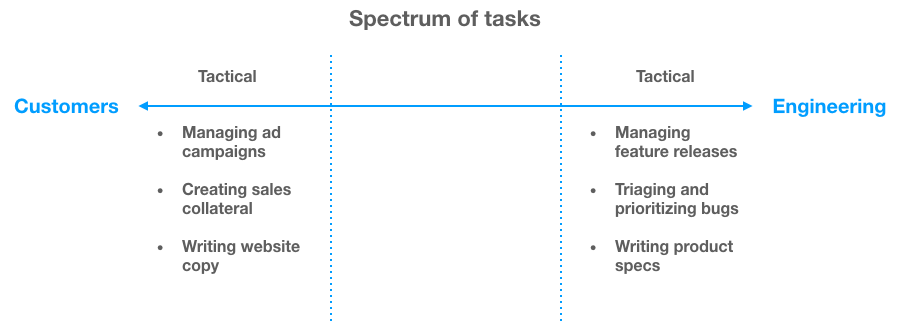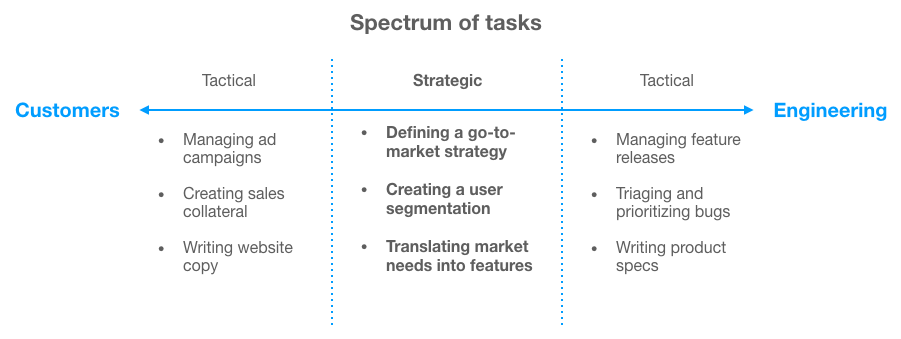What's the difference between a PM and a PMM?
A deep dive on the differences and similarities between product managers and product marketing managers
|
|
|
Tasks spectrum | Strategic collaboration | Uber example
People new to the tech and software space often ask: what's the difference between a product manager (PM) and a product marketing manager (PMM)?
The "brain-dead" answer is that PMM focuses on marketing. But what exactly does that entail? And if it's as simple as: one's a marketer and one isn't, why do both titles imply some overlap by leading with the word: product?
A helpful way to think about this is to focus on the extremes.
When you examine the most tactical, nitty-gritty tasks each role is likely to do, do those tasks focus more on communicating with the customer using the product or the engineering team building the product?
The spectrum of PM and PMM responsibilities (Top)
To visualize this, you can think of a spectrum: engineering on one side (coding the product) and customers on the other side (using the product).

On one end of the spectrum, you have the most tactical duties that deal with communicating and interfacing with the customer: writing website copy, managing the ad campaigns to acquire customers, interviewing users. On the opposite end, you've got the tactical duties that deal with communicating and interfacing with engineering: creating tickets to track feature improvements, prioritizing which bugs to fix, etc.

If team has both a PM and a PMM, it's extremely likely that the PM will take the lead on the all the tactical tasks on the engineering side of the spectrum and vice versa for the PMM.
There will always be some variation and exceptions, but the center of gravities often tend to adhere to this type of clustering.
PM and PMM collaboration on product strategy (Top)
Ok, so what happens in the middle? Product strategy.
The middle of this spectrum is where PMs and PMMs collaborate on product strategy decisions and tasks. Ultimately, the work done in the center of this spectrum will effectively dictate the tactical tasks that each focuses on in their side of the spectrum.
For example, a PM and PMM might collaborate on defining the go-to-market strategy for a new product launch or they might partner on an exercise to carefully define the target customer so that they can socialize that with executives, sales, engineering, etc.

💡 Prepping for interviews? Check out our PMM interview prep or PM interview prep to built your skills
Variance in PM and PMM delineation on strategic tasks
On strategic product questions, which role takes the lead on each specific aforementioned activity tends to vary a lot company to company and sometimes even team to team within companies.
At a company level variance is typically driven by the codification of the roles over time (e.g., most PMMs assume X is a core part of their role, so they take the lead). This codification can be formal (specified and agreed upon by the leadership) or informally built into the culture.
Think different: an alternative model for PM responsibilities
In fact, some companies like Apple, don't typically staff PMs on projects.
Instead, they rely on a partnership between PMMs and EMs (engineering managers) to cover the full spectrum of tasks. Given the framework we've covered, one can see how certain organizations could operate this way.
It's also common for companies, especially startups, to begin with a leaner structure and then add PMs over time as the volume of tasks grow. For example, a product might have no PM or PMM at first and just have an EM handling some of the product tasks (i.e., Stripe didn't have PMs for the first few years and relied on selected EMs to manage products). Overtime, if the company and product grows, teams typically flesh out to fully tackle the range of tasks.
Intra company deltas are typically project driven
Inside the same company, there are typically two key things that drive the variance:
- Particular strengths and interests of the PM and PMMs involved (e.g., a particular PMM might be great at defining target markets, creating customer profiles, etc and so takes the lead).
- Relative work loads of PM/Ms involved (e.g., if a PMM is swamped with another project, maybe a PM kicks off or defines the whole go-to-market strategy)
Regardless of who ends up taking the lead on each piece of the strategic work, this should now give you a mental model for the delineation between PM and PMMs.
Example: task break down over the life of a feature (Top)
Let's look at a specific example: imagine the PM and PMM duo that recently launched Uber Health.

One could imagine that the PM and PMM collaborated to answer many strategic questions (along with other key decision makers like engineering, design, operations), including questions like which key features will be required for a successful launch?
After that, the PMM likely devoted a bulk of his/her efforts to ensuring the communication to customers about these features was clear and effective, including tasks like finalizing their splash page (e.g., how to position the product, which features to highlight, specific copy and images, etc.).
On the flip side, the PM likely focused on working with the engineering team to develop the required features like HIPAA compliance, a Health Dashboard, test the product, prioritize fixes, etc.
Obviously, this example only highlights a tiny portion of the overall work required to launch this product. Yet, it should illustrate the nature of the collaboration between PM and PMMs, as well as the delineation between the two roles.
Summary
In a nutshell, PM and PMMs tend to collaborate on strategic items (e.g., defining a go-to-marketing strategy) and differentiate themselves on the tactical tasks of interfacing with either customers or engineering teams.
That said, remember that these delineations aren't hard, permanent rules and there will definitely be outliers as each company / product team settles into a formation that works best for them.
Read this next:
- Product requirements document (PRD) overview
- Associate product manager (APM) programs overview
- Career path of a product manager
- Big tech product manager compensation
- The role of a product manager
- Product management, a day in the life
- The three types of companies that hire PMs
- Must-read content for PMs
- CS degree required for PM?
- Product owner vs. PM
P.S. Are you preparing for PM interviews?
Real interview questions. Sample answers from PM leaders at Google, Amazon and Facebook. Plus study sheets on key concepts.



